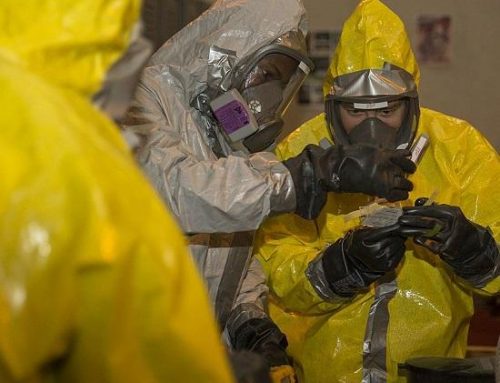Safety orientation is an important part of a successful Hazardous Waste Operations and Emergency Response (HAZWOPER) program. A safety orientation helps familiarize workers with the hazards and risks present in their work environment, as well as the safety protocols and procedures that are in place to protect them. In this article, we’ll provide an overview of safety orientation and offer some helpful tips for businesses looking to implement it.
What is Safety Orientation?
Safety orientation is the process of educating workers about the hazards and risks present in their work environment, as well as the safety protocols and procedures that are in place to protect them. A safety orientation can include various activities such as training sessions, safety videos, or hands-on demonstrations.
The specific content of a safety orientation will depend on the nature of the work being performed and the potential hazards involved. It’s important to carefully assess the risks and tailor the safety orientation to the specific needs of the workers and the business.
Why is Safety Orientation Important?
Safety orientation is important because it helps familiarize workers with the hazards and risks present in their work environment, as well as the safety protocols and procedures that are in place to protect them. By participating in a safety orientation, workers can better understand the potential hazards and risks involved in their work and how to protect themselves from injury or illness.
In addition, the use of safety orientation is often required by law or regulatory agencies, such as the Occupational Safety and Health Administration (OSHA), as a means of ensuring the safety of workers and the general public. By participating in safety orientation, businesses can demonstrate their commitment to safety and help ensure compliance with regulatory requirements.
Safety orientation is also an effective way to promote a culture of safety within an organization. By regularly reviewing and updating safety protocols and procedures, businesses can help ensure that safety is a top priority for all employees.
Tips for Implementing Safety Orientation
Here are ten tips to help your business implement effective safety orientation:
- Determine the content of the safety orientation: Carefully assess the risks and hazards in your workplace to determine what topics to cover in the safety orientation.
- Involve employees in the process: Involving employees in the development of the safety orientation can help ensure their buy-in and support for the program.
- Use a variety of formats: Consider using a variety of formats, such as training sessions, safety videos, or hands-on demonstrations, to make the safety orientation engaging and effective.
- Regularly review and update the safety orientation: Regularly review and update the safety orientation to ensure it is still effective and in compliance with any changes in laws or regulations.
- Ensure that all employees participate: All employees, including new hires and temporary workers, participate in the safety orientation.
- Make it interactive: Encourage employees to ask questions and participate in discussions to make the safety orientation more interactive and effective.
- Follow established protocols: Follow established protocols for conducting the safety orientation to ensure consistent and reliable training.
- Keep thorough records: Maintain thorough records of all safety orientation activities.
- Include supervisors and managers in the safety orientation: It’s important to involve supervisors and managers in the safety orientation to ensure that they are aware of the hazards and risks present in the workplace and how to protect their employees.
- Supplement the safety orientation with ongoing training: Safety orientation should be the starting point for ongoing safety training. Consider implementing regular safety training sessions or refresher courses to keep employees informed and up-to-date on safety protocols and procedures.
Conclusion
Safety orientation is an important part of a successful HAZWOPER program. By implementing effective safety orientation and regularly reviewing and updating your program, you can help protect the health and well-being of your employees and the community. It’s worth noting that safety orientation is just one part of a successful HAZWOPER program. Other key elements include personal protective equipment, monitoring procedures and equipment, and emergency response planning. To ensure the safety of your workers and compliance with regulatory requirements, it’s important to have a well-rounded program that addresses all of these areas.
Do you need HAZWOPER Online Training?
Try a free demonstration of HAZWOPER: Safety Orientation
Excerpt from the Outline of our Understand HAZWOPER Online Training Course
The following outline summarizes the major points of information presented in the program. The outline can be used to review the program before conducting a classroom session, as well as in preparing to lead a class discussion about the program.
HAZWOPER’s ultimate goal is keeping you safe, which is more than simply a matter of knowing how to do the right thing.
— Staying safe also depends on maintaining a “safety-first” attitude.
Every time that you enter a highly contaminated site, you need to think about the hazards you’ll face.
— Objects you encounter could burn your skin on contact.
— Breathing the air might permanently damage your lungs.
But you’re a professional… and you’ve taken precautions.
— You’re familiar with the substances onsite.
— You’ve consulted the SDSs and the HAZMAT reference books.
— You know what these chemicals react with, how to handle them… and what their medical effects are.
You’re wearing the proper level of personal protective equipment (PPE).
— Your self-contained breathing apparatus (SCBA) is in perfect working condition, and has a full tank of oxygen.
— You’ve thoroughly tested your radio, and you know the signals that you’ll use to communicate with coworkers in the “hot zone.”
— You have the monitoring equipment you need to detect contaminants in the area.
You’ve been extremely thorough in your preparations, but there’s one other thing that you should never overlook… what’s going on between your ears.
— Developing the correct way of thinking is more important to staying safe than your PPE.
— With right orientation, you’ll be sure to get your job done properly… without exposing yourself to undue risk in the process.
Let’s begin by looking at how bad mental habits form, and what their consequences can be.
— In every way, the one-hundredth time that you enter a hazardous area should be the same as the first.
Whenever you’re in a contaminated area, you must be highly aware of your surroundings… and conscious of the many things that can spell danger.
— Above all, you must never become nonchalant.
— Even a moment’s inattention could have serious consequences.
No one should know this better than you, because you perform tasks that most people would be too frightened to do.
— Nevertheless, as you work around hazardous materials more and more, you may find them less and less intimidating.
— This is inevitable.
— Whenever you repeat a dangerous activity over and over again, it becomes less threatening.
While this can be a good thing, it also can lead to the formation of some unfortunate habits.
— For everyday examples of this, you don’t have to look any farther than the nearest major highway.
Here, you’ll find people so used to driving that they don’t concentrate on the road anymore. Instead they:
— Talk on cell phones.
— Fiddle with the radio.
— Turn to talk to people in the back seat.
— Discipline their children.
In short, they do any number of things that someone piloting a two-thousand pound vehicle shouldn’t do.
— As a result, the inevitable occurs… they have accidents.
— Their inattention results in crippling injuries or even deaths.
— And in many cases, other drivers are the ones who suffer.
Something similar can happen to you, too.
— As you gain more experience in hazardous waste operations, some of the dangerous things that you do can begin to seem routine, even risk-free.
Keep in mind, though, that these hazards are just as perilous as they were the first time you encountered them.
— Your thinking may have changed, but the danger hasn’t.
Becoming complacent about safety is one of the down sides to the learning process.
— It often results from being highly familiar with the task at hand.
Ironically, it is this familiarity that allows you to do a job well.
— When you practice anything for a long period of time… driving, playing a musical instrument, or working around hazardous materials… basic procedures become second nature.
— You’re no longer as aware of them when you do them.
— If this didn’t happen, any complex task would be a lot harder.










